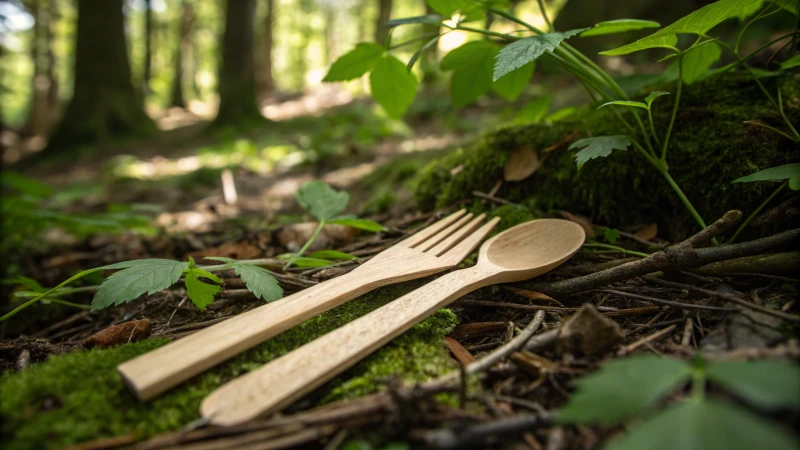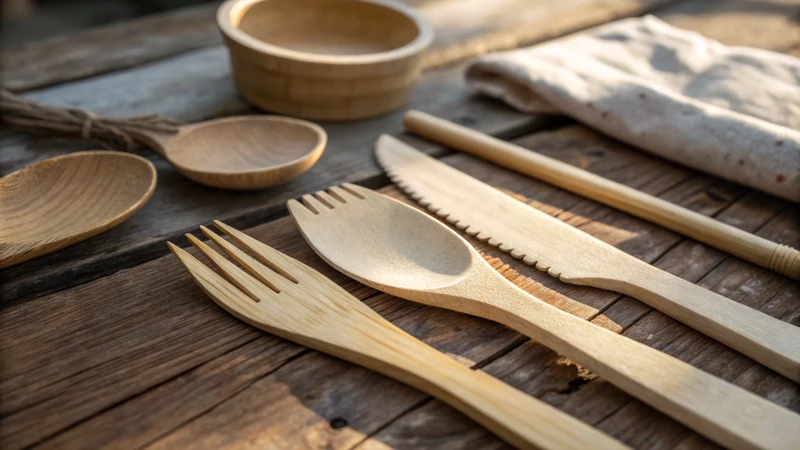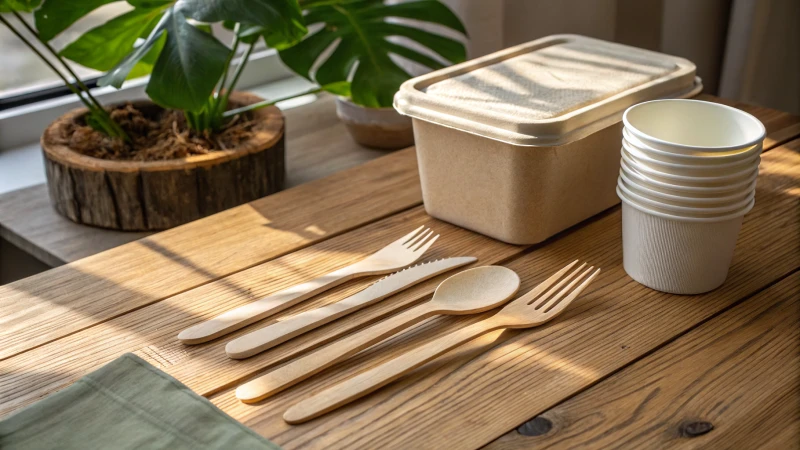
Ever wondered if your wooden forks and spoons can truly return to nature?
Yes, disposable wooden cutlery is generally compostable if conditions are right, like in commercial composting facilities where high temperatures and moisture levels prevail. Home composting might take longer, but it’s still possible.
I remember the first time I switched to wooden cutlery at a family barbecue. It felt great knowing we weren't adding to the plastic pile. But, I wondered how truly compostable they were. After some digging, I learned that while these wooden utensils can indeed break down, the process needs just the right blend of heat and moisture. Commercial composting facilities typically offer these conditions, speeding things up significantly. At home, it's a slower process, but with patience and a bit of care, like ensuring the compost pile stays warm and moist, those wooden forks and knives can eventually return to nature. It’s comforting to know that a simple choice can make a real difference.
Disposable wooden cutlery is compostable at home.False
It may decompose, but home composting conditions are often insufficient.
High temperatures aid composting of wooden cutlery.True
Commercial facilities provide high temperatures necessary for quick decomposition.
Why is Wooden Cutlery Compostable?
Ever wondered why wooden cutlery is the green champion of utensils? Let's dive into what makes them so compostable and how they're turning tables on plastic!
Wooden cutlery is compostable because it's crafted from natural materials like birch or bamboo that break down easily in compost conditions. Whether in a compost facility or your backyard bin, these utensils can decompose efficiently.

Understanding Compostability
Compostability isn't just a buzzword—it's the magical process of materials transforming back to nature. When I first switched to wooden cutlery, it felt like I was doing my small bit for the planet. These utensils, made from birchwood or bamboo, seamlessly return to the earth, ensuring I'm leaving no toxic footprint behind.
Key Factors for Compostability
-
Material Origin: The secret sauce is in the wood! Birch and bamboo are my personal favorites because they decompose faster than you can say "eco-friendly." Bamboo, especially, grows like a weed—making it a superstar renewable resource1.
-
Processing Methods: Ever wondered what makes wooden cutlery eco-friendly? It's all about keeping things natural. By minimizing processing and skipping chemical additives, these utensils stay green. Unlike their plastic counterparts, which I find laden with chemical stabilizers2, wooden cutlery is pure goodness.
-
Composting Conditions: Getting the right mix of moisture, temperature, and air is key. While industrial composting facilities have this down to an art, I've managed some decent results at home by balancing carbon-rich browns with nitrogen-rich greens.
| Condition | Industrial Composting | Home Composting |
|---|---|---|
| Moisture | High | Moderate |
| Temperature | 50-60°C | 25-40°C |
| Decomposition Time | 2-3 months | 6-12 months |
Comparing Wooden and Plastic Cutlery
Switching to wooden cutlery was a no-brainer for me. Unlike plastic that clogs our planet for centuries, wooden options simply melt away into nature. Even biodegradable plastics have their quirks—often needing specific industrial settings to break down properly.
But what truly wins me over is how wooden cutlery supports a circular economy by cycling nutrients back into our soil. This journey doesn't just benefit the environment; it transforms dining experiences with a rustic charm that plastic can never match. For businesses looking to stand out, wooden cutlery is a sustainable choice that speaks volumes about their commitment to the planet. It’s not just about the eco-benefits but also about adding that extra touch of authenticity and care.
Wooden cutlery is made from birchwood or bamboo.True
Wooden cutlery is crafted from biodegradable materials like birchwood or bamboo.
Plastic cutlery decomposes faster than wooden cutlery.False
Plastic cutlery takes hundreds of years to decompose, unlike wooden cutlery.
How does composting wooden cutlery compare to plastic utensils?
Have you ever wondered about the real impact of your choice between wooden and plastic cutlery? Let’s explore how these everyday utensils stack up in the sustainability race.
Wooden cutlery is a more sustainable option than plastic utensils because it naturally biodegrades, while plastic lingers in landfills for centuries. For optimal composting, wooden cutlery requires the right balance of microorganisms, moisture, and oxygen.

Composting Conditions for Wooden Cutlery
I remember the first time I decided to switch from plastic to wooden cutlery. It was during a family picnic, and I wanted to make sure we were minimizing our environmental footprint. Wooden cutlery, made from renewable materials like birch or bamboo, can naturally decompose in the right composting conditions3. This requires sufficient moisture, oxygen, and a thriving microbial environment—kind of like giving nature a helping hand to do its thing.
Setting up a compost pile at home was surprisingly rewarding. Over several months, I watched as our wooden utensils slowly turned back into the earth. For those who want quicker results, industrial composting facilities can transform these utensils into rich compost in just a few weeks.
Challenges with Plastic Utensils
The struggle with plastic is all too real. I still remember the frustration of seeing our waste bin filled with plastic forks and knives after hosting parties. These items are made from petroleum-based materials and can take hundreds of years to decompose, all the while releasing harmful chemicals into the soil.
Here's a comparison of decomposition rates:
| Material | Decomposition Time |
|---|---|
| Wooden Cutlery | 3-6 months (industrial) |
| 1-2 years (home) | |
| Plastic Utensils | 400+ years |
Enhancing Composting Efficiency
To speed up composting at home, I found chopping the wooden cutlery into smaller pieces made a big difference. This increases the surface area available for those hard-working microbes. Adding a balanced mix4 of carbon-rich (think dried leaves) and nitrogen-rich materials (like kitchen scraps) further optimizes decomposition.
Real-World Applications
Businesses are catching on, too. I’ve noticed more restaurants and catering services making the switch to wooden cutlery as part of their sustainability goals. It’s not just about being eco-friendly—it’s also about aligning with consumer preferences for sustainable products5, which can enhance a brand’s reputation.
However, it’s crucial for businesses to ensure proper disposal mechanisms are in place. Simply choosing wooden over plastic isn’t enough; understanding how to effectively dispose of them is key to maximizing environmental benefits.
In the end, it’s all about making informed choices that lead us toward a greener future. Whether it’s exploring new disposal methods or integrating sustainable practices into daily operations, every small change counts.
Wooden cutlery decomposes faster than plastic utensils.True
Wooden cutlery decomposes in months, while plastic takes hundreds of years.
Plastic utensils can be composted in industrial facilities.False
Plastic utensils are non-biodegradable and not suitable for composting.
How Can I Compost Wooden Utensils at Home?
Transforming wooden utensils into compost is like giving them a second life in your garden.
To compost wooden utensils effectively, break them into smaller pieces, maintain a balanced carbon-to-nitrogen ratio, and ensure proper moisture and aeration. These steps promote faster decomposition in a home composting setup.

Understanding Compostability of Wooden Utensils
Ever since I started my sustainability journey, I’ve been fascinated by how everyday items can return to nature. Wooden utensils are naturally biodegradable, but they remind me of the tortoise in that fable—slow and steady wins the race. They decompose at a leisurely pace compared to food scraps. To speed things up, it's crucial to create the right conditions. Always use untreated wooden cutlery6 because chemicals can play spoiler and slow down the process.
Preparing Wooden Utensils for Compost
I remember the first time I added wooden utensils to my compost pile. They seemed out of place among the food scraps and leaves. But then I learned that breaking them down into smaller pieces is like giving them a head start. Chopping or crushing them increases their surface area, making it easier for microbes to do their magic. It’s a small effort for a big reward in the composting world.
| Step | Action |
|---|---|
| Break down | Chop into smaller pieces |
| Balance ratio | Maintain carbon-nitrogen |
| Ensure aeration | Turn compost regularly |
Maintaining Optimal Compost Conditions
- Carbon-Nitrogen Ratio: Wooden utensils are high in carbon, so it's like adding a dash of dry ingredients. Pair them with nitrogen-rich materials like green leaves or grass clippings—think of it as adding moisture or eggs to the mix.
- Moisture Level: Keep your compost pile moist but not soggy. A good rule is the 'sponge test' - it should feel like a damp sponge.
- Aeration: Regularly turning your compost pile introduces oxygen, essential for microbial activity.
Avoiding Common Pitfalls
In my early composting days, I learned the hard way about what not to add. Avoid anything varnished or painted—those toxins are party crashers in your compost pile. Always look for that compostable certification7 to ensure everything's above board.
Embrace these steps and transform your wooden utensils into rich soil. For more insights on making your composting efforts as effective as possible, explore expert tips on eco-friendly waste management that can help you reduce household waste while nurturing your garden.
Wooden utensils decompose faster than food scraps.False
Wooden utensils decompose slower than organic waste like food scraps.
Untreated wooden utensils are suitable for composting.True
Untreated wood decomposes naturally, unlike varnished or painted wood.
What Are the Environmental Benefits of Choosing Wooden Cutlery Over Plastic?
Ever wondered how a simple switch to wooden cutlery can make our planet happier? Let's dive into the greener choice and see why it matters.
Opting for wooden cutlery over plastic offers eco-friendly benefits like biodegradability, reduced plastic pollution, and sustainable sourcing. Wooden utensils use less energy to produce and break down naturally, preserving ecosystems.

Understanding the Impact of Materials
When I first learned about the environmental effects of plastic utensils, it was like a light bulb went off. They’re made from fossil fuels, which isn’t great news for our carbon footprint. On the flip side, wooden cutlery comes from renewable resources. Imagine this: every time we choose wood over plastic, we’re essentially opting for a cleaner, greener future.
| Attribute | Wooden Cutlery | Plastic Cutlery |
|---|---|---|
| Raw Material | Renewable wood | Non-renewable petroleum |
| Decomposition | Biodegradable | Not biodegradable |
| Production Energy | Lower energy requirements | High energy consumption |
The Role of Compostability
The concept of compostability is a game-changer. I remember attending a friend's outdoor event where they used wooden utensils. Afterward, they just tossed them into the compost bin! Wooden cutlery naturally turns into nutrient-rich soil, especially when proper conditions—like moisture and aeration—are maintained. This process not only reduces waste but turns it into something beneficial.
Imagine hosting events with wooden cutlery and watching waste transform into compost that helps gardens flourish. It's an easy step towards sustainable waste management8.
Reducing Plastic Pollution
Plastic pollution is a topic close to my heart. With millions of tons entering our oceans annually, it feels urgent to act. Every time I pick up a wooden fork instead of a plastic one, I’m doing my bit to lessen this crisis. It’s empowering to know that such small changes can lead to fewer plastic utensils in landfills and oceans, protecting our environment for future generations.
Switching to plastic alternatives9 is a tangible step towards a cleaner planet.
Contribution to Eco-Friendly Practices
For businesses, embracing wooden cutlery isn’t just about eco-friendliness—it’s about leadership. Imagine procurement officers like Michael or Sarah championing these sustainable choices in their sectors. It’s not just appealing to green-conscious consumers; it’s a powerful statement of environmental responsibility10.
By making these choices, businesses can enhance their sustainability credentials, fostering a brand image that stands for something larger than itself. Whether in public projects or high-end restaurants, opting for wooden cutlery is a decision that resonates deeply with our collective responsibility to the planet.
In summary, while there's always more to learn, these insights highlight why wooden cutlery is a smart choice over plastic. Shifting towards sustainable options is crucial in tackling the pressing environmental issues we face due to plastic waste.
Wooden cutlery is made from renewable resources.True
Wooden cutlery is typically produced from renewable wood sources.
Plastic cutlery is compostable like wooden cutlery.False
Plastic cutlery is not biodegradable or compostable like wooden cutlery.
Conclusion
Disposable wooden cutlery is generally compostable under optimal conditions, particularly in commercial facilities. Home composting is possible but slower; proper moisture and temperature are essential for effective decomposition.
-
Explore why birchwood is favored for its biodegradability and sustainability, making it an ideal choice for eco-friendly cutlery. ↩
-
Understand the chemicals that make plastic cutlery less environmentally friendly compared to wooden alternatives. ↩
-
Learn about optimal conditions for composting wooden cutlery efficiently at home or in industrial setups. ↩
-
Explore techniques to boost the composting efficiency of wooden cutlery by balancing carbon and nitrogen levels. ↩
-
Understand why consumers are increasingly favoring sustainable products and how this trend impacts businesses. ↩
-
This link provides information on why untreated wooden cutlery is better for composting due to the absence of harmful chemicals. ↩
-
Understand the significance of compostable certification for ensuring safe and effective decomposition in composting setups. ↩
-
Discover how compostable materials like wooden cutlery contribute to efficient waste management systems and reduce landfill reliance. ↩
-
Learn about various materials that serve as sustainable alternatives to plastic, emphasizing their environmental benefits. ↩
-
Explore how businesses can implement sustainable practices to enhance their eco-friendly image and reduce environmental impact. ↩

